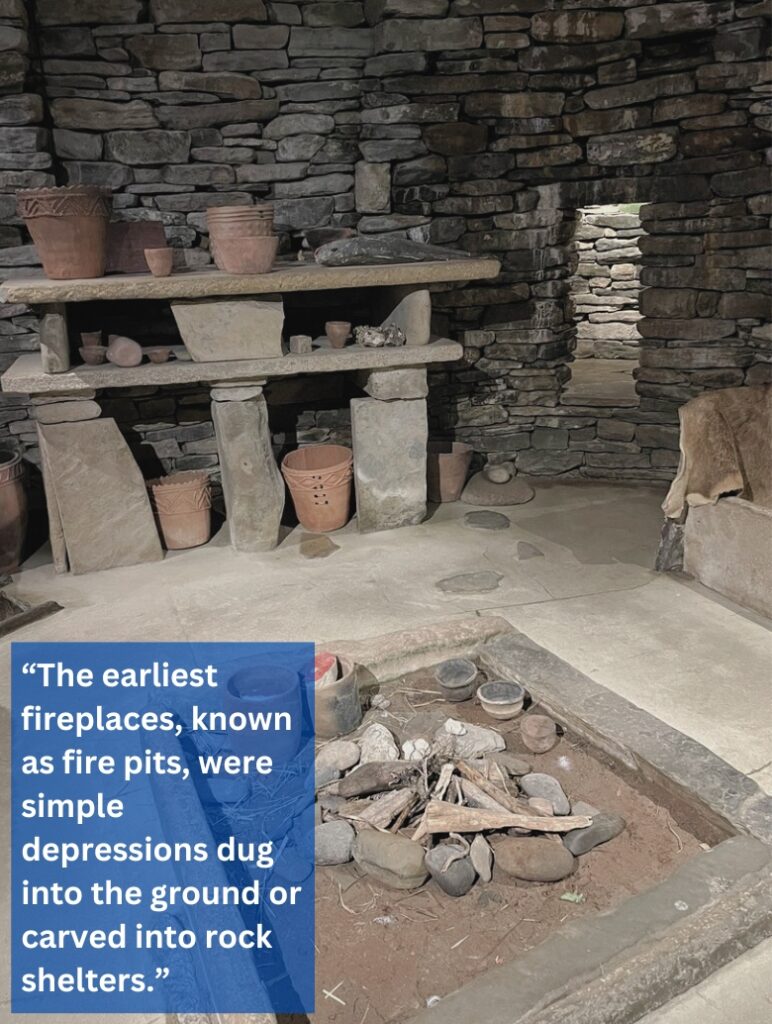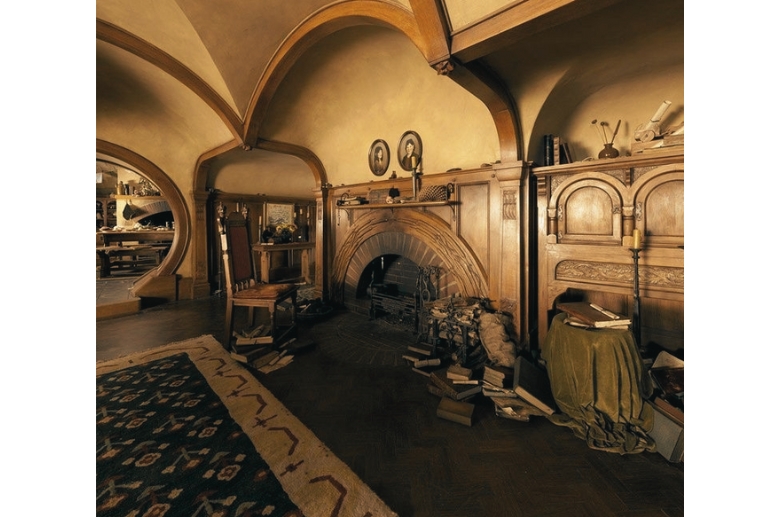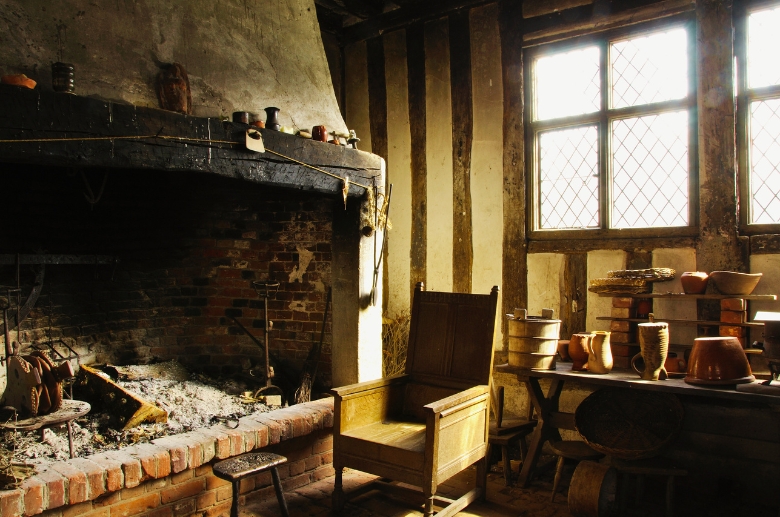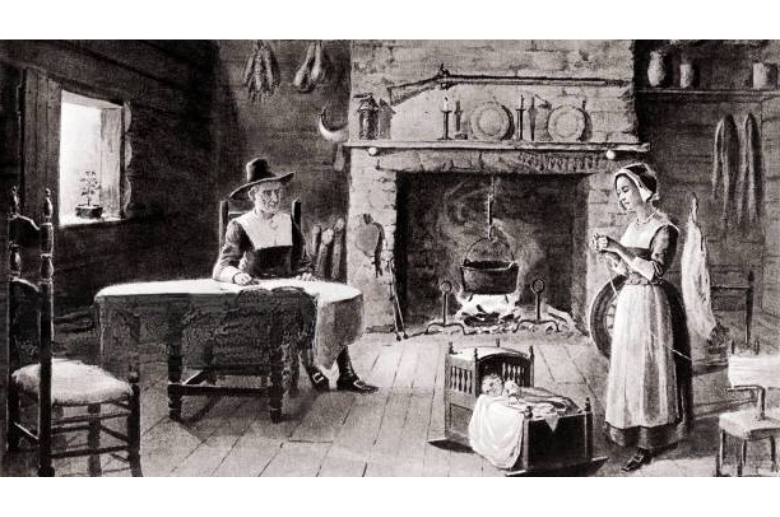From flickering campfires in prehistoric caves to grand fireplaces adorning modern living rooms, the fireplace has played a pivotal role in human civilization. It has been a source of warmth and sustenance and a symbol of community, comfort, and elegance.
As the fireplace evolved from a necessity to a design centerpiece, its styles have mirrored different eras’ changing tastes and trends.
This article takes you on a captivating journey through the history of fireplaces and their styles. You’ll explore the diverse styles that have shaped these iconic features of our homes.
Let’s get started!
The Ancient Beginnings of Fireplaces

Humankind’s fascination with fire dates back to the earliest civilizations. Fire provided warmth, protection from predators, and a means for cooking food. The earliest fireplaces, known as fire pits, were simple depressions dug into the ground or carved into rock shelters.
These fire pits served as the focal point of human settlements, providing a gathering place for warmth and social interaction.
——
Do You Need to Hire Chimney & Fireplace Expert?
Get free quotes from qualified experts near you. No commitment required!
——
Fire Pits and Early Hearths
The first fire pits were rudimentary, but they served a vital purpose. They provided a controlled environment for fire, allowing early humans to harness its power for cooking, warmth, and protection.
As humans developed more sophisticated tools and techniques, they began constructing raised hearths, which offered several advantages over ground fires.
The Transition from Ground Fires to Raised Hearths
Raised hearths were elevated above the ground, often on a platform of stone or clay. This elevation had several benefits:
- Improved combustion: Raised hearths allowed for better airflow, leading to more efficient burning and less smoke.
- Reduced fire hazards: Raising the fire off the ground minimized the risk of accidental fires spreading to surrounding flammable materials.
- Cooking efficiency: Raised hearths provided a more stable cooking surface, making it easier to control the heat and cook food evenly.
Materials and Design
Enter the river rocks and basic masonry era, where craftsmanship met elemental resources. The construction of early hearths reflected the availability of materials and the level of technological advancement in each region. Common materials included:
- River rock: River rocks were readily available and could be easily stacked to form the walls of a hearth.
- Clay: Clay was used as a binding agent to hold rocks together and to create a smooth, heat-resistant surface.
- Basic masonry: As humans developed masonry techniques, they began to construct hearths using stone slabs or bricks.
The Simplicity of Design Due to Necessity
In these early stages, simplicity wasn’t a stylistic choice but a necessity. The designs were born out of the need for efficient heating, cooking, and safety. Functionality reigned supreme, and the unembellished beauty of these fireplaces lay in their practicality.
Each element served a purpose, and every design choice was a response to the challenges of daily life.
Cultural Significance of Fireplaces
Fireplaces served as the heart of the home, a gathering place for families and communities to share stories, celebrate milestones, and forge bonds.
The crackling flames and soothing warmth have inspired countless works of literature, movies, and traditions, solidifying their place in our cultural tapestry.
Fireplaces in Literature
In literature, fireplaces often symbolize comfort, home, and the passage of time. They provide a backdrop for intimate conversations, family gatherings, and moments of reflection.

Charles Dickens’ “A Christmas Carol” famously features a fireplace as the focal point of Scrooge’s transformation.
Fireplaces in Movies
Movies frequently employ fireplaces to evoke a sense of nostalgia, romance, and homeliness. The flickering flames create a cozy atmosphere, while the gathering around the hearth often signifies shared experiences and emotional connection.

Think of The Lord of the Rings: The Fellowship of the Ring (2001). The fireplace in Bag End, the home of Bilbo Baggins, is a place of comfort and warmth for the hobbits. It is also where Gandalf reveals the truth about the One Ring to Frodo Baggins, setting the stage for the epic adventure to follow.
Fireplaces in Traditions
Fireplaces are deeply ingrained in various cultural traditions, often associated with celebrations, rituals, and storytelling. In many cultures, fireplaces are considered the heart of the home, symbolizing the gathering of family and community.
They serve as a focal point for holiday celebrations, storytelling sessions, and the passing down of traditions from generation to generation.
History of Fireplaces and Their Styles Timeline
Over the centuries, the design and style of fireplaces have evolved, reflecting the changing needs, technologies, and artistic sensibilities of different eras.
Ancient Fireplaces
The earliest fireplaces were simple hearths, dug into the ground or constructed from stone or clay. The Romans, renowned for their architectural prowess, incorporated fireplaces into their elaborate villas and bathhouses.
These fireplaces, often adorned with intricate mosaics and sculptures, reflected the Romans’ appreciation for aesthetics and craftsmanship.
In Ancient Greece, fireplaces were central to both public and private life. The hearth (estia), a common home area, served as a sacred space for offerings to the gods.
Timeline:
- 10,000 BC: Evidence of early fireplaces found in caves and open-air sites
- 3,000 BC: Fireplaces become more common in permanent dwellings
- 1,000 BC: Fireplaces in ancient civilizations become more elaborate and decorative
Medieval Fireplaces

During the Middle Ages, fireplaces became more sophisticated, incorporating chimneys to draw smoke from dwellings. Fireplaces were often the centerpiece of great halls in castles and manor houses, providing a source of heat and a gathering place for lords, ladies, and servants.
Their construction became more elaborate, incorporating stone, brick, and timber. In addition to their functional role, fireplaces became symbols of status and wealth.
Timeline:
- 5th century AD: Chimneys are introduced, leading to the development of more efficient fireplaces
- 11th century AD: Fireplaces in medieval castles become more elaborate, with stone surrounds and decorative carvings
- 15th century AD: Fireplaces become more common in homes of the wealthy, with the use of iron and metalwork
——
Do You Need to Hire Chimney & Fireplace Expert?
Get free quotes from qualified experts near you. No commitment required!
——
Renaissance and Tudor Fireplaces
The Renaissance, an era of intellectual and cultural rebirth, left an indelible mark on the design and artistry of fireplaces. During this period, fireplaces transitioned from mere hearths for cooking and heating to focal points of architectural beauty, reflecting the Renaissance’s fascination with classical art, symmetry, and proportion.
Renaissance fireplaces epitomized the era’s artistic ideals, characterized by symmetrical proportions, intricate carvings, and classical motifs. These fireplaces were often made of marble or stone, with a rectangular surround and a mantelpiece adorned with delicate reliefs, pilasters, and intricate geometric patterns.
Timeline:
- 14th century AD: Renaissance fireplaces begin to appear in Italy
- 16th century AD: Renaissance fireplace design spreads throughout Europe
- 17th century AD: Renaissance fireplaces become increasingly popular in England and America
Georgian and Colonial Fireplaces

The Georgian and Colonial periods in North America (1714-1776) saw a distinct style of fireplace emerge, reflecting the architectural and design trends of the time. These fireplaces were characterized by their clean lines, symmetry, and use of classical motifs.
Georgian fireplaces were typically made of wood or marble, with a rectangular surround and a mantelpiece. They were often decorated with intricate carvings and inlaid work, sometimes featuring a pediment or broken pediment.
Colonial fireplaces were often larger and more rustic than their Georgian counterparts. They were typically made of brick or stone, and built-in cupboards or shelves often flanked them. Colonial fireplaces were often the home’s centerpiece for cooking, heating, and social gatherings.
American Adaptation
The Georgian and Colonial styles of fireplaces were adapted to suit the different climates and materials available in North America.
In New England, where wood was plentiful, fireplaces were typically made of wood. In the Mid-Atlantic region, where stone was more common, fireplaces were often made of stone. And in the South, where brick was the most readily available material, fireplaces were often made of brick.
Differences Between New England, the Mid-Atlantic, and the South
There were also some regional differences in the style of Georgian and Colonial fireplaces. In New England, fireplaces were typically smaller and more ornate, focusing on delicate carvings and inlaid work.
Fireplaces in the Mid-Atlantic region were typically larger and had a more rustic appearance, emphasizing simple lines and durable construction. Conversely, fireplaces in the South were known for their grandiose size and intricate decoration, which reflected the area’s affluence and plantation culture.
The fireplace was the heart of the home in the Georgian and Colonial periods. It was used for cooking, heating, and social gatherings. It was also a place where families would gather to tell stories, play games, and sing songs.
Benjamin Franklin’s Influence
Benjamin Franklin, a prominent figure in the American Enlightenment, played a significant role in developing fireplaces in North America. He invented the Franklin stove, a more efficient and safer fireplace design that became popular in the colonies.
The Franklin stove was a revolutionary design that improved the efficiency and safety of fireplaces. It was made of cast iron, a more efficient conductor of heat than the brick or stone typically used for fireplaces. The Franklin stove also had a closed firebox, which prevented sparks from flying out and causing fires.
Franklin’s invention of the Franklin stove was a significant advancement in the history of fireplaces. It made fireplaces more efficient and safer, and it helped to popularize the use of fireplaces in homes throughout North America.
Timeline:
- 18th century AD: Georgian fireplace design becomes popular in England
- 19th century AD: Georgian fireplace design spreads to America
- 20th century AD: Georgian fireplaces remain popular, particularly in traditional homes
Victorian and Edwardian Eras
The Victorian and Edwardian eras (1837-1910) marked a period of significant transformation in the design and function of fireplaces. These eras witnessed a shift from the simpler, more functional fireplaces of the Georgian and Colonial periods to more elaborate and ornate designs that reflected the growing affluence and artistic sensibilities of the time.
Various stylistic influences, including Gothic Revival, Renaissance Revival, and Arts and Crafts, characterized the era. These influences were reflected in the design of Victorian fireplaces, which often featured intricate carvings, decorative tiles, and stained glass.
Victorian fireplaces were typically made of cast iron, wood, or marble. Cast iron was popular because it was durable and could be molded into various shapes and designs. Wood and marble were also used to create more ornate fireplaces, often with intricate carvings and inlaid work.
Use of Tiles, Cast Iron, and Intricate Wood Mantels
Tiles were a popular decorative element for Victorian fireplaces. They were often used to create patterns and designs on the fireplace surround and could also be used to line the firebox. Cast iron was used to create the mantelpiece, often a fireplace focal point.
Intricate wood mantels, often carved with scenes from nature or mythology, were also popular.
Introduction of the Fireplace Insert
The fireplace insert was a new invention during the Victorian era. It was a metal insert that fit into the fireplace firebox and helped improve efficiency. Fireplace inserts were also popular because they could create various looks, from traditional to modern.
Variety in Design
The design of Victorian fireplaces varied greatly, reflecting the era’s wide range of stylistic influences. Some fireplaces with pointed arches and intricate carvings were designed in the Gothic Revival.
Some fireplaces were designed in the Renaissance Revival style with classical columns and pediments, while others were designed in the Arts and Crafts style with simple lines and natural materials.
Fireplaces were a status symbol in the Victorian era. Wealthy Victorians often had several fireplaces in their homes, and they would often decorate them with expensive materials, such as marble and stained glass. Fireplaces were also a way for Victorians to show off their wealth and taste.
Timeline:
- 19th century AD: Victorian fireplace design becomes popular in England
- Late 19th century AD: Victorian fireplace design spreads to America
- Early 20th century AD: Victorian fireplaces continued to be popular, but more modern designs gradually replaced them
Modern to Contemporary Fireplaces
The modern and contemporary era (1910-present) has brought a renewed focus on simplicity and function to the design of fireplaces. Gone are the ornate Victorian and Edwardian designs, replaced by sleek, minimalist fireplaces that reflect modern homeowners’ changing tastes and priorities.
One of the most significant changes in fireplace design in recent years has been the shift from traditional wood-burning fireplaces to gas and electric fireplaces. These fireplaces are more convenient and efficient than wood-burning fireplaces and do not require a chimney. They are also safer, as they do not emit smoke or carbon monoxide.
Simplicity and Function
Modern and contemporary fireplaces are characterized by their clean lines and simple designs. They are often made of metal, glass, or stone and feature minimalist surrounds and mantels. This reflects the growing trend towards minimalism in home design.
Focus on Ambiance Over Heating
In the past, fireplaces were primarily used for heating. However, there has been a shift towards using fireplaces for ambiance rather than heat in recent years. This is partly due to the availability of more efficient heating systems and the growing popularity of open floor plans, which make it difficult to heat a home with a fireplace alone.
Materials and Design
Metal, glass, and stone are popular materials for modern and contemporary fireplaces. These materials are durable, easy to clean, and they can create a sleek, modern look. Fireplaces are often designed to complement the home’s overall décor, and they may feature built-in lighting or other decorative elements.
In addition to the minimalist trend, rustic and craftsman styles in fireplace design have also been revived. These styles are characterized by using natural materials, such as wood and stone, and their simple, functional designs.
——
Do You Need to Hire Chimney & Fireplace Expert?
Get free quotes from qualified experts near you. No commitment required!
——
Future of Fireplaces
As we move into the future, fireplaces are evolving to reflect our changing needs, tastes, and technological advancements. Here are some of the key trends that are expected to shape the future of fireplaces:
- Smart Fireplaces: Smart fireplaces are equipped with sensors and connectivity features that allow them to be controlled remotely via smartphones, tablets, or voice commands. This level of automation provides enhanced convenience and safety.
- Eco-Friendly Designs: Sustainability is a growing concern for homeowners, and fireplace manufacturers are responding with eco-friendly designs that minimize environmental impact.
- Aesthetic Innovations: Designers are experimenting with new materials, textures, and finishes to create fireplaces that seamlessly integrate with contemporary interior styles. Sleek lines, minimalist forms, and natural elements like stone and wood are gaining popularity.
- Prefab Fireplace: Alongside these advancements, the integration of prefab fireplaces is becoming increasingly popular. These units, pre-assembled and ready for installation, offer a blend of convenience and modern design, fitting perfectly into the contemporary home aesthetic.
The future of fireplaces is also about personalization. Advancements in technology allow for the customization of fireplace experiences based on individual preferences. Smart fireplaces can learn user habits and adapt settings, creating a personalized ambiance.
Additionally, augmented reality (AR) and virtual reality (VR) technologies may enhance the fireplace experience, allowing users to interact with virtual flames or project captivating visuals onto the fireplace surround.
Conclusion
The history of fireplaces and their styles is a testament to the enduring appeal of this remarkable creation. As we adapt and evolve, the fireplace will remain a cherished feature of our homes, symbolizing warmth, comfort, and the enduring human spirit. It is a legacy that will continue illuminating our lives for generations.






